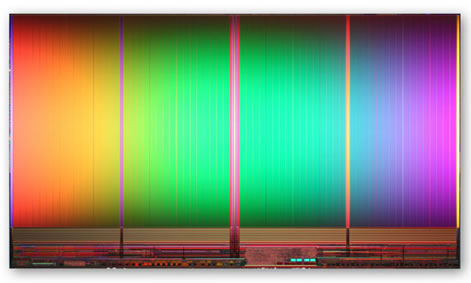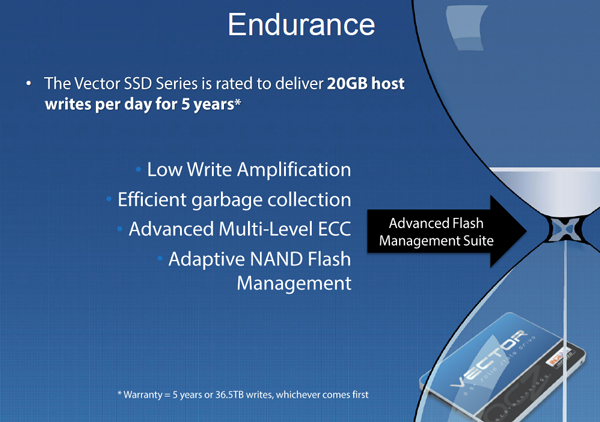OCZ Vector 256 GB Review: An SSD Powered By Barefoot 3
Measuring The 256 GB Vector's Write Endurance
Endurance: Kind Of A Big Deal
Write endurance is a term often thrown around in discussions of solid-state storage because we all worry about that point when an SSD is no longer able to reliably hold our data (even though very few of us have actually seen such a thing happen).
If you have an SSD in your notebook or mainstream desktop, write endurance isn't something that should keep you up at night. It's highly improbable that you'll ever write enough data per day to exhaust the rated life space of the NAND flash cells composing your drive. Both Micron and Intel estimate that the average desktop user writes between 7-10 GB worth of information per day. Even if you use an exaggerated number, basic math assures us that you almost can't render your SSD useless within its warranty period. If you were to run into a reliability issue, it'd be far more likely to come from some sort of firmware-oriented bug.
How the rated write endurance of NAND changes at each new lithography node is interesting to track, though, as are the ways vendors address the physical realities of NAND wear-out. OCZ tells us that the Vector leverages 25 nm ONFi 2.x-compliant NAND from IMFT. However, we've seen this flash rated at 3000 and 5000 P/E cycles, and we're curious to know which specification applies to the Vector.
Our estimates come from monitoring each drive's media wear indicator (referred to as the MWI), which counts down from 100 to 1. Because the number of program-erase cycles a NAND cell can withstand is finite, the MWI is designed to facilitate a rough estimate of endurance.
In theory, once you reach the end of the counter, all of the memory's rated P/E cycles are exhausted. That's not to say something bad happens when you hit the bottom, but nobody wants to entrust irreplaceable data to a drive operating on borrowed time, either. Naturally, enterprises place a lot of importance on the MWI because it represents a "safe zone."
Fewer Cycles, In Theory; Does That Matter?
Get Tom's Hardware's best news and in-depth reviews, straight to your inbox.
| Sequential Workload, Queue Depth=1, 2 MB | |||
|---|---|---|---|
| Row 0 - Cell 0 | Intel SSD 320 | OCZ Vector | Samsung 840 Pro |
| NAND Type | Intel 25 nm MLC | Intel 25 nm MLC | Samsung 21 nm MLC |
| RAW NAND Capacity | 320 GB | 256 GB | 512 GB |
| IDEMA Capacity (User-Accessible) | 300 GB | 256 GB | 512 GB |
| Overprovisioning | 7% | 0% | 0% |
| P/E Cycles Observed (IDEMA) | 5460 | 2965 | 2512 |
| P/E Cycles Observed (Raw) | 5119 | 2965 | 2512 |
| Host Writes per 1% of MWI | 16.38 TB | 7.59 TB | 12.86 TB |
Our analysis places the endurance of a 256 GB Vector somewhere around 759 TB using sequential writes. If the MWI is to be believed, a bit of math ([Host Writes per 1% of MWI * 100] / Capacity) tells us we're dealing with NAND rated at 3000 P/E cycles. This isn't the best stuff we've seen, but we're really not worried about it either, particularly at a 256 GB capacity point. If we assume you perform 10 GB of writes per day, it’d take more than 200 years to wear down the drive's NAND cells using our workload.
But the story doesn't end there. Endurance ratings apply to each flash cell. But because higher-capacity SSDs simply have more on-board flash, it takes longer to write across all of their cells, yielding a higher endurance rating. Now, somewhat strangely, OCZ gives us just one endurance number for all of the drives in its Vector family: 36.5 TB of writes. This comes out to about 20 GB of writes per day for five years (the duration of the warranty).
Naturally, this raises some questions. OCZ's 36.5 TB figure is a lot less than the 759 TB we derived, and 20 GB of writes per day is a lot more than the 7-10 GB we consider to be "average."
Our endurance rating tries to isolate the endurance of the NAND itself by using a pattern whereby host writes match NAND writes. In the real-world, host writes consist of multiple transfer sizes at various queue depths. As a result, the amount of data you write on the host tends to be a fraction of what's actually written to the NAND. This phenomenon is know as write amplification (NAND writes/host writes). On the 256 GB Vector, a 759 TB endurance rating with a write amplification of 1x is equivalent to 36.5 TB at a write amplification of ~20x.
Rarely does write amplification get that high, though. Here's an example after writing a mixture of random and sequential data:
On an SSD 520, write amplification reaches as high as 2.9x when it's faced with completely incompressible files. In a best-case scenario, SandForce's technology compresses the data so that NAND writes are represented by just 17% of the space requested by the host.
| Impact of Random Accesses On Write Endurance | |
|---|---|
| Workload Ratio: 35% 128 KB Sequential, 65% 4 KB Random128 KB Sequential: 66% Reads, 34% Writes4 KB Random: 66% Reads, 34% WritesFull Span, QD=1, ~3 Hours | Write Amplification |
| Intel SSD 520, Incompressible Data | 2.9x |
| Intel SSD 520, Compressible Data | 0.17x |
| OCZ Vector | 2.8x |
Clearly, OCZ's Barefoot 3 controller does not employ compression the same way SandForce's logic does. In theory, then, write amplification is, at best, 1x across a large sequential write. The real-world isn't limited to one type of access pattern, though. You end up with a mix of sequential and random I/O. Even when we mix things up a bit, we see write amplification as high as 2.8x. Even in that situation, it'd take ~40 years to exhaust the 256 GB Vector's endurance, assuming 10 GB of writes per day. Since ratings still scale with capacity, even the 128 GB Vector should demonstrate 20 years of endurance. Providing you're not intentionally taxing the drive the way we do, you shouldn't have any issues within the five-year warranty OCZ provides.
Current page: Measuring The 256 GB Vector's Write Endurance
Prev Page Power Consumption: Idle And PCMark 7 Next Page OCZ's Barefoot 3 Paves The Way For Great Performance-
gnesterenko "In the real world, it's almost a certainty that you wouldn't be able to tell the difference between them (or a number of the nearly-as-fast but tangibly less expensive models featured each month in Best SSDs For The Money)."Reply
This, This, This. All SSDs are pretty amazing at this point for me, the average user. What I care fare more about is - Are they reliable. At the moment, it still seems that Intel holds the reliability crown. Reviews like this are great, for sure, but they don't answer the most important question sadly. -
acku gnesterenko"In the real world, it's almost a certainty that you wouldn't be able to tell the difference between them (or a number of the nearly-as-fast but tangibly less expensive models featured each month in Best SSDs For The Money)."This, This, This. All SSDs are pretty amazing at this point for me, the average user. What I care fare more about is - Are they reliable. At the moment, it still seems that Intel holds the reliability crown. Reviews like this are great, for sure, but they don't answer the most important question sadly.Reply
Let's make one thing clear. Endurance, reliability, durability, they all refer to different things.
When it comes to reliablity, everything we know is rather anecdotal. There are no published RMA rates (only return rates and for a 500 sample size), so its rather flawed. Second, two users subject their SSDs in different ways. The first may have more random data in their workload. You can't make an evaluation that drive x failed for user y therefore its bad. What you do matters. Unlike HDDs, performance and characteristics of the drive change based on what you do to it. Since no two users do the same thing with their system, the only real way to test this out is to get a few thousand SSDs, subject them to the same workload in a big data center for a few years. I'd love to do this but naturally, it's really not feasible. :)
Cheers,
Andrew Ku -
mayankleoboy1 So basically all good SSD's are constrained by the SATA3 interface. I cant wait for the direct PCIE interface(express pcie ?) to become standard.Reply -
Hupiscratch Do these drives (specially the Samsung 840) support TRIM in RAID 0 arrays or this is a property related to the chipset?Reply -
acku HupiscratchDo these drives (specially the Samsung 840) support TRIM in RAID 0 arrays or this is a property related to the chipset?Reply
That's a mobo thing. You're going to want a 7-series chipset from Intel.
Cheers,
Andrew Ku -
edlivian i dont care how much slower the crucial m4 is compared to the new kids on the block, I will keep stocking them for myself and company, since that is the only one that has never failed me.Reply -
acku Reply10447277 said:i dont care how much slower the crucial m4 is compared to the new kids on the block, I will keep stocking them for myself and company, since that is the only one that has never failed me.
Glad to hear the m4s are working out for you! Indeed, they have a pretty good track record.
Cheers,
Andrew Ku -
dingo07 So should I buy some of thier stock now...? It can't get much lower than them going out of business from the lawsuits... :/Reply -
I just hope that there won't be as many firmware updates with this drive. I got tired of that with my past 2 OCZ SSD's (Vertex 3 & Vertex Turbo). It was way too often, almost as much as my GPU drivers. That being said, they both have given me no issues whatsoever and run like champs. I see a 256GB Vector in my future.Reply

